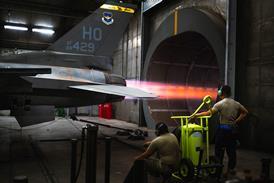Surveillance systems are a major part of the Israeli defence and aerospace industry. Israel Aircraft Industries' Tamam division began producing stabilised electro-optical (EO) systems as a natural progression from providing precision control and navigation systems for land, air, sea and space systems.
Jacob Galili, Tamam manager sales and marketing navigation and sensors, says the group started with electro-mechanical gyros and accelerometers while current technologies include ring laser gyros (RLG) and fibre-optic gyros (FOG). It is now developing MEMS micro electro-mechanical devices, he says. "We believe we're one of the few companies that do all four [sensor technologies]," he adds. The FOG has a volume of 50ml and weighs around 0.3kg. "We believe it is one of the smallest in the world," says Galili. The devices are used in a range of systems, from armoured vehicles to unmanned air vehicles.
The RLGs and accelerometers are "100% Israeli technology", says Galili. The FOGs, however, are the result of "some co-operation, although the product is 100% built in Israel".
Tamam has begun MEMS development with an accelerometer for an inertial measurement unit, although the bulk of work has been associated with creating the "production infrastructure, not doing the theory. We had to master the production, that's the difficult bit, so we did it first," says Galili. A rate sensor may follow.
Experience with rate sensors and gyros allowed Tamam to develop stabilised payloads. It now offers a range of products for large fixed-wing platforms down to the smallest UAVs.
Ehud Oren, deputy director Tamam optronics directorate, says the company's 380mm (15in) Multi-mission Optronic Stabilised Payload (MOSP) and Plug-in Optronic Payload (POP) share common technology, but not identical sensors. MOSP - and HMOSP, a version designed for the harsher helicopter environment - are internally identical. Tamam offers helicopter sensor upgrades, based on linking one of the company's EO packages with the machine's - usually 1553 - databus, and then to a helmet-mounted or multifunction display. Tamam has fitted HMOSP to the Mil Mi-24 Hind, which required Tamam to fit its own databus to the Soviet-era attack helicopter.
POP is a 15-16kg system contained in a 255mm-diameter ball. As well as tactical UAVs, the system has proved to be popular with ground forces as a mast-mounted surveillance system. Tamam offers a variety of POP sensors mounted in a removable "slice" allowing one turret to be used with a combination of EO devices. Oren says slices can contain day/night cameras, a night sensor with a laser rangefinder, or a day/night camera with a pointer capability: "The user selects the slice for a mission, it gives a lot of operational flexibility." In many instances the customer orders different numbers of turrets and slices. New slices are also compatible with the old turrets, allowing acquisition of the latest sensors without having to replace the whole system.
Initial systems had relatively small focal lengths and low resolution, but technology development means a fivefold resolution increase as well as 770mm lenses. Taman offers its second generation 8-12µm and third generation 3-5µm infrared (IR) sensors.
The division also offers the sensors as part of "turnkey image intelligence solutions", comprising the EO payload, a ground station, datalinks and aircraft integration. Datalinks are bought in, as are some of the ground station elements, says Oren. Tamam started as a sensor vendor, grew into a payload provider and is now a systems supplier, he adds.
Elop senior director ISR business development, Shai Oren, says parent company Elbit supplies all elements of the intelligence cycle - collection, processing, distribution and attack - as well as sensors for use from space down to ground level. All can be routed through a single Elbit-developed exploitation centre.
Elop produces space-based 1m-resolution panchromatic cameras and its long-range oblique LOROPS EO/IR reconnaissance pod in the same facility in Rehovot using common technology. The next step is hyperspectral cameras, says Oren. Such devices linked with signals intelligence will make it easier to find hidden targets "to find any signature possible", but the problem, he says, is not in developing the sensor but creating the target database.
Elop supplies its own IR sensors - the detectors are produced in a joint venture with Rafael - as well as the complete sensor packages, many of which are long-range systems. It is believed the Advanced Multi-sensor Payload System (AMPS) has a 50-60km (27-32nm) range. AMPS combines a FLIR, an image intensified charge-coupled device camera, and two daylight sensors, narrow and wide field of view daylight cameras into a single 85kg turret for fixed-wing applications. A company official says it can be operated between 5,000ft (1,525m) and 35,000ft, and up to 260kt (480km/h), feeding images to onboard consoles. An inertial measurement unit in the turret provides data on where the sensors are pointing. This is displayed on the console, allowing the turret to be steered by moving a cursor.
Liora Topaz, Elop project manager space systems, says the company's telescopes are "uniquely light" and can be used in space and airborne applications. Elop is moving towards providing the complete package, says Topaz. "We do the telescope, data compression and storage system, datalinks and antennas. Hopefully, with the next-generation systems, we will produce the ground station as well."
Elop uses the same build facilities and technologies in its LOROP pod, a visual and IR reconnaissance pod contained in a pod shaped like a Lockheed Martin F-16 drop tank and with a flight envelope stretching to 50,000ft and Mach 1.6. The pod splits into three: the forward section contains a datalink and environmental system; the centre has the cameras; while the rear houses the datalink and electronics. Officials say Elop has prototype medium-/low-altitude cameras that are fitted in a replacement centre section. The datalink is two-way, allowing mission revision in-flight. A GPS satellite/inertial-navigation system on the camera maintains pointing accuracy.
Rafael has stepped into the airborne reconnaissance market by modifying its Litening targeting pod to create the Reccelite, a gimballed system that allows the camera to be pointed at an off-track target. Most competitors are fixed-direction systems. Shlomo Levy, Rafael Reccelite and Litening marketing manager, says the pod can produce vertical, forward, side and oblique imagery. This also means the aircraft carrying a Reccelite can manoeuvre aggressively and the pod will remain focused on the path of interest, he says. The Reccelite, which has an internal inertial measurement unit, can provide accurate co-ordinates for points of interest. It comprises the pod, a datalink and the ground station. The datalink is used to transmit the intelligence data to the ground and redirect the pod in the air. Imagery is recorded on a solid-state recorder in the pod. The system can also overlay images.
Source: Flight International























